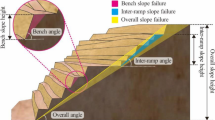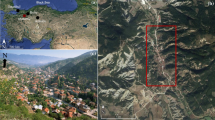Abstract
The risk of slope failure in the Chuquicamata open-pit mine was analyzed using Geographic Information System (GIS) software and modeling techniques. Models incorporated various component layers at a relatively large map scale (1:5000): alteration, geotechnical unit, proximity to major faults (VIF), GSI (geological strength index), slope (from digital elevation model), proximity to watertable (difference grid between topography and modeled watertable), and composite structural density grid (VIF, smaller faults, and fracture frequency); not all layers were used in all models. Three modeling techniques were used: fuzzy logic, in which parameters in each component layer were ranked by mine geotechnical experts according to their influence in promoting slope failure, and two data-driven techniques, weights-of-evidence and logistic regression, in which statistical correlation of training points (known failures) with parameters were used to derive a relative probability of failure. Because most slope failures are controlled by structure, VIF and smaller faults were divided by orientation into subsets with dip direction parallel, opposite, and normal to slope aspect; these orientations promote circular and planar, toppling, and wedge-type failures, respectively. Density grids of these subsets show high-risk areas for individual failure types.
The models demonstrate sensitivity of the analysis to (1) selection of component layers, (2) selection of training points, (3) classification and ranking of categorical parameters, and (4) data problems in certain layers. Predicted high-risk zones in the final models show a high degree of correspondence with recent, post-model failures. Such models can be used to anticipate future pit design concerns. The results presented here illustrate how vast amounts of data, in multiple geo-referenced layers, can be analyzed and modeled using GIS techniques for predictive studies at relatively large map scales. Such modeling techniques could provide a powerful tool for predictive modeling in a vast array of large-map-scale applications requiring similar data integration and evaluation.














Similar content being viewed by others
References
Agterberg, F. P., Bonham-Carter, G. F., Cheng, Q., Wright, D. F., 1993, Weights of evidence modeling and weighted logistic regression for mineral potential mapping, in Davis, J. C., and Herzfeld, U. C., eds, Computers in Geology: 25 Years of Progress: Oxford Univ. Press, Oxford, p. 13–32.
An, P., Moon, W. M., Rencz, A., 1991, Application of fuzzy set theory to integrated mineral of exploration: Can. Jour. Explor. Geophysics v. 27, no. 1, p. 1–11
Bonham-Carter, G. F., 1994, Geographic Information Systems for geoscientists; Modelling with GIS: Computer Methods in the Geosciences vol. 13: Pergamon Press, Oxford, 398 p
Bonham-Carter, G. F., Agterberg, F. P., and Wright, D. F., 1989, Weights of evidence modeling: a new approach to mapping mineral potential, in Agterberg, F. P., and Bonham Carter, G. F., eds., Statistical Application in the Earth Sciences: Geol. Survey Canada, Paper 89–9, p. 171–183
Dilles, J., Tomlinson, A., Martin, M., and Blanco, N., 1997, El Abra and Fortuna complexes: A porphyry copper batholith sinistrally displaced by the Falla Oeste: Congreso Geológico Chileno, VIII, Antofagasta, v. III, p.1883–1887
Kemp, L. D., Bonham-Carter, G. F., Raines, G. L., and Looney, C. G., 2001, Arc-SDM: Arcview extension for spatial data modeling using weights of evidence, logistic regression, fuzzy logic and neural network analysis. http://www.ige.unicamp.br/sdm/defaultSDM_e.htm, last accessed 4 October 2006
Lindsay, D. D., 1998, Structural control and anisotropy of mineralization in the Chuquicamata porphyry deposit, Chile: unpubl. doctoral dissertation, Dalhousie Univ., 381 p
Ossandón, G., Fréraut, R., Gustafson, L. B., Lindsay, D. D., Zentilli, M., 2001, Geology of the Chuquicamata mine, a progress report: Economic Geology v. 96, no 2, p. 249–270
Tomlinson, A., and Blanco, N., 1997, Structural evolution and displacement history of the West fault system, Precordillera, Chile: Part 1. Premineral history. Part 2. Synmineral history: Congreso Geológico Chileno, VIII, Antofagasta, v. III, p. 1873–1882
Acknowledgments
This study was supported financially by CODELCO Norte, also acknowledged for access to their geotechnical database. We wish to thank Alex Calderon and Ricardo Torres of CODELCO Norte for their logistical support during field work and pit access, and for helpful discussions on geotechnical aspects of slope stability analysis and data issues. CODELCO Norte geologists Danko Zaro and Rodrigo Araya helped in the data collection and analysis. CODELCO Norte, in Chuquicamata, Chile, Geologic Data Systems in Denver, Colorado, and the Colorado School of Mines in Golden, Colorado are thanked for their kind support in allowing the authors time to conduct the research. Discussions on GIS modeling with Gary Raines and editorial reviews by Raines and Graeme Bonham-Carter were helpful in strengthening the manuscript.
Author information
Authors and Affiliations
Corresponding author
Rights and permissions
About this article
Cite this article
Nelson, E.P., Connors, K.A. & Suárez S., C. GIS-Based Slope Stability Analysis, Chuquicamata Open Pit Copper Mine, Chile. Nat Resour Res 16, 171–190 (2007). https://doi.org/10.1007/s11053-007-9044-7
Received:
Accepted:
Published:
Issue Date:
DOI: https://doi.org/10.1007/s11053-007-9044-7




